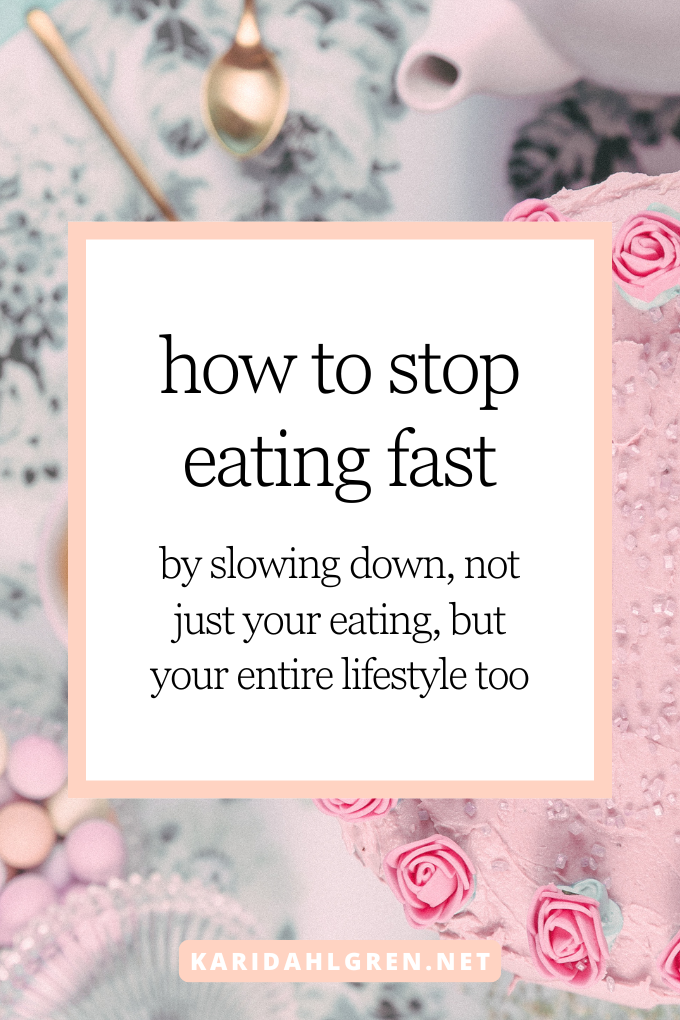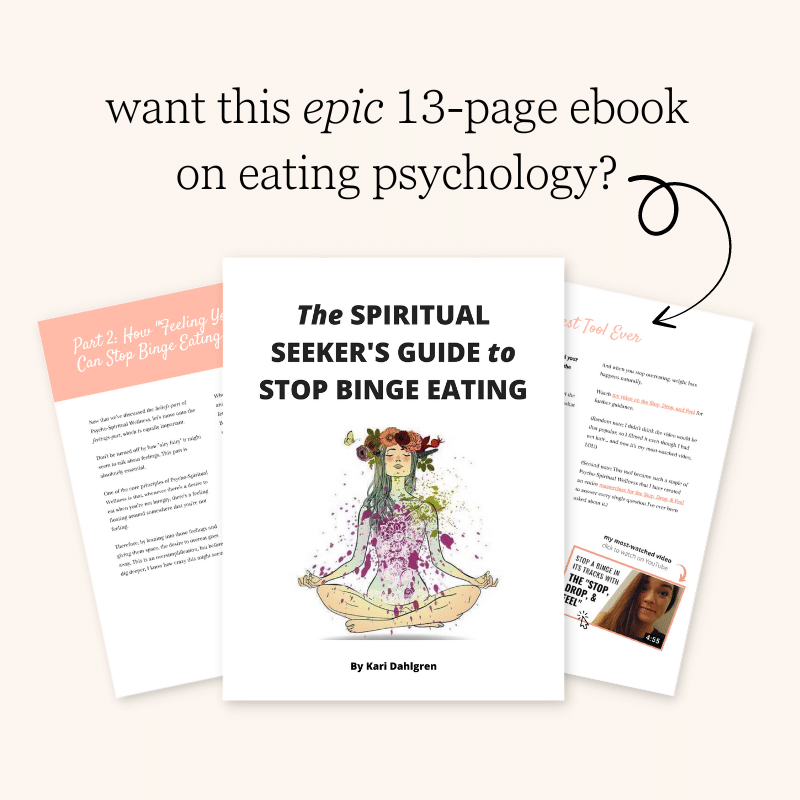
If you want to learn how to stop eating fast, you may have to learn how to adopt a slower lifestyle first. Pioneer in the emotional eating space, Geneen Roth, sums it up perfectly in her famous quote, “The way we do one thing is the way we do everything.” If you eat fast, you probably live fast too.
I used to be a fast eater, and it overlapped with a fast-paced lifestyle. I was always stressed and rushing from one obligation to the next, and it definitely showed in my eating habits.
As I unraveled my old patterns of compulsive eating, part of my journey overlapped with a deep dive into minimalism and slow, simple living. I have no doubt that slowing down my life helped me learn how to stop eating fast as a natural byproduct.
In this article, we’ll explore the steps you can take to learn how to stop eating fast too. As an eating psychology coach, I’ll put extra emphasis on the psychology behind our eating patterns, including our eating speed. And of course I’ll back everything up with clinical evidence so that you know these are proven ways to support your well-being.
The Connection Between Fast Eating and Fast Living
While Geneen Roth poetically coined the phrase “the way we do one thing is the way we do everything,” science can back it up—especially in the context of eating speed.
A 2024 study published in Brain and Behavior found that people with more impulsive or inattentive tendencies were more likely to struggle with loss-of-control eating.[1] When your mind is racing or scattered, it’s easier to lose track of your body’s signals and slip into autopilot with food.
The study even found that inattention was a bigger culprit than impulsivity—showing just how much a busy, distracted mind can spill over onto your plate. This doesn’t mean something is “wrong” with you if you eat quickly—it simply means your eating speed reflects the rhythm of your life.
If you’re constantly rushing, multitasking, or feeling scattered, meals will naturally mirror that pace.
Why Eating Slowly Matters
Eating slowly isn’t just about savoring your food (though that’s a wonderful perk). It also changes the way your body processes food and communicates fullness.
A 2024 study published in The British Journal of Nutrition found that when people slowed their eating pace, they consumed less food at each meal because their bodies had more time to register fullness.[2]
Another randomized trial published in Appetite showed that small shifts—like taking smaller bites and chewing longer—had a measurable impact on how much participants ate.[3]
It’s important to pause here, because “eating less” can sound like the end goal—and diet culture has already pushed that message hard. But the real value of slowing down isn’t about restriction. It’s about connection.
Eating slowly reveals your body’s natural signals: the first signs of hunger, the gradual build of satisfaction, and the comfortable stopping point. Many people who rush their meals miss those signals entirely, which can leave them either stuffed or still searching for something more. When you slow down, you’re not forcing control—you’re letting your body lead.
There’s even biology behind it. Research shows that eating slowly gives fullness hormones like GLP-1 and PYY the chance to tell your brain you’ve had enough, making it easier to stop when you feel comfortably full, not overfilled.[4]
How to Stop Eating Fast: Why Mindful Eating Helps But Isn’t the Whole Answer
Mindful eating often tops the list of ways to stop eating fast, and rightly so. A 2025 study published in the Journal of Experimental Psychology found that mindful eating caused participants to eat more slowly than the control group of normal eaters.[5]
Another study published in Obesity Science & Practice found that when participants paid close attention to the sensory experience of food—noticing texture, taste, and aroma—their eating pace naturally slowed.[6] Mindful eating is practically synonymous with slow eating.
But here’s the catch: knowing that mindful eating is helpful doesn’t make it easy to do. It asks for time, presence, and single-tasking—three things our fast-paced culture doesn’t practice very often. And if you’re carrying unprocessed stress or emotions into a meal, mindful eating can feel like an even bigger hurdle, because you’re suddenly confronted with those feelings right at the table.
This is why mindful eating alone can feel frustrating. You may know it’s good for you, but if you live at a fast pace—rushing to and from obligations, barely catching your breath—slowing down at mealtime can feel almost impossible.
Eating habits don’t exist in isolation. They mirror the rhythm of your whole life.
So yes, mindful eating can help you slow down, but it isn’t the full solution. To make it practical, it has to be part of a bigger, holistic approach that extends far beyond the plate.
Tips to Stop Eating Fast: Slow Your Life to Slow Your Eating
This is where slowing down your life comes in—because once you do, eating slowly becomes a natural byproduct of your slower lifestyle. When the rhythm of your day softens, meals often follow suit.
Here are research-backed ways to slow your life so your meals can follow:
1. Practice Mindfulness in Daily Life
The most obvious step for slowing down your lifestyle is to bring mindfulness into your daily life through single-tasking. Whatever you’re doing, focus only on the task in front of you. Try not to let your thoughts wander onto something else, like your to-do list that you need to accomplish later.
For instance, when you’re washing dishes, try to focus only on washing dishes and nothing else. Notice the pop of the bubbles and the temperature of the water on your skin.
When you train your mind to slow down and focus on one thing at a time, that rhythm naturally carries into the way you eat.
Want hard clinical evidence that mindfulness matters? Long-term meditators show observable changes in brain structures tied to attention, self-awareness, and emotional processing—like thickening in the prefrontal cortex and insula.[7] This means mindfulness can literally reshape the parts of your brain responsible for presence.
So when I say that a slower lifestyle trickles into your relationship with food, I mean it on both a psychological and biological level. The brain rewires itself around what you practice most often—and when you practice mindfulness, you’re training yourself to move through life, and meals, at a calmer pace.
2. Spend More Time in Nature
Another way to slow down your lifestyle and therefore slow down your eating is through the great outdoors. Nature has a remarkable way of shifting us into a calmer state, and studies back this up.
A 2019 study on forest bathing (shinrin-yoku) found that spending time in forests, compared to urban settings, significantly reduced cortisol levels and blood pressure.[8] A 2024 review went further, finding that exposure to nature-based therapies consistently reduced stress, depression, and anxiety in randomized controlled trials.[9]
Spending time in nature doesn’t have to mean hiking deep into the woods—it can be as simple as sitting under a tree, walking through a park, or even tending to plants on your balcony. What matters is the shift in environment: the sights, sounds, and rhythms of the natural world cue your nervous system to downshift. This helps anchor your body in “rest-and-digest” mode, making it easier to learn how to stop eating fast by addressing the root of the matter.
3. Breathe Slower to Live Slower
Even something as simple as your breath can change the pace of your whole day. According to a 2025 review published in Stress & Health, structured breathwork practices like the “A52 Breath Method” help regulate the nervous system, strengthen stress resilience, and improve mental health.[10]
The review highlighted several benefits: slower breathing helps you shift out of fight-or-flight mode and into “rest-and-digest,” improves emotional regulation, enhances focus, and even supports recovery from anxiety and depression.
When you train your breath, you’re training your whole system to downshift into calm.
Try the A52 Breath Method before meals: inhale for a count of five, exhale for a count of five, and hold for a count of two. Just a few minutes of paced breathing can anchor you in the present moment—and that calmer rhythm naturally carries into how you eat.
4. Protect Space and Resist Overcommitment
One of the biggest barriers to slowing down—whether in life or at the table—is simple: we’re too busy. Busyness keeps the nervous system stuck in “go” mode, and when you’re constantly rushing from one task to the next, meals become just another box to check.
Research supports this. A 2023 study on role overload found that when people take on too many demands, mental health and quality of life decline sharply.[11] The antidote isn’t productivity hacks—it’s protecting space.
Saying no, setting boundaries, or lightening your schedule aren’t just time-management strategies; they’re nervous-system resets.
Why does that matter for eating? Because eating slowly depends on being in “rest-and-digest.” If your days are overfilled, you’ll bring that same frantic pace to the table. But if you create even small pauses in your day, your body has a chance to exhale—and meals will naturally follow suit.
Try it this week: protect 30 minutes of white space on your calendar, or decline one obligation that doesn’t serve you. Notice how that breathing room changes the way you show up, not just in life, but also with your food.
How to Stop Eating Fast by Living Slower
Learning how to stop eating fast isn’t about forcing yourself to chew more times or timing your bites with a stopwatch. It’s about creating a life that supports slowness, presence, and connection both on and off the plate.
When you start to shift the rhythm of your days—by practicing mindfulness, spending time in nature, breathing with intention, and saying no to what doesn’t serve you—eating slowly stops feeling like a task. It becomes a natural reflection of the calm you’ve cultivated.
As Geneen Roth once said, “We are using the food as a doorway to understanding the rest of our lives.” If you’re intrigued by the psychology behind our eating habits, keep climbing down the rabbit hole by downloading my free ebook below!




This article showed up at the right time. Subconsciously this is what I have been seeking for a long time in my life, balance and a slower pace that doesn’t leave me feeling overwhelmed and burnt out. Thank you for being a guiding light on my journey to healing and wholeness.
Kathryn, I am genuinely honored to be considered a guiding light on your journey. Thank you for the wonderful compliment, and I wish us both a slow and healing pace in the days, months, and years ahead 🙂
I am 69 years old and have been overweight all of my life. I was sexually abused growing up and rejected by my family. I have used food as a substitute. I can lose weight on low carb but I’m not sure that’s healthy. I really enjoy your writings and would very much like to eat for nutrition instead of for emotional comfort.
Sandi, thank you for trusting me enough to share a piece of your story with me. I am so sorry for what you have gone through, and I think eating for emotional comfort is so understandable given the circumstances! I hope all the emails and tools I share help you on your journey to healing and well-being.